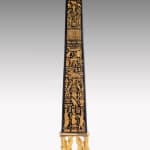Toleware and Ormolu Egyptian Revival Obelisk
GERMANY – BERLIN, 1800-1810
73.5 x 19 x 19 cm
Further images
Provenance
Jeremy Ltd., London. Private European Collection.A four-sided Egyptian Revival toleware obelisk supported on an ormolu stand which has four legs which are in the form of sphinxes. Mounted on a square stepped ormolu base.
This obelisk exemplifies the European fascination with Egyptian culture, which reached its peak after Napoleon Bonaparte’s expedition to Egypt in 1798–1801.
Werner and Mieth, Berlin, active 1792–1819: Werner and Mieth was founded in Berlin in 1792 by Christian Gottlob Werner, Gottfried Mieth and Friedrich Luckau Jr. The workshop became famous for its well-made bronzes and mounted glassware, and it was the most important Berlin manufacturer of hand-made luxury goods in gilded bronze for more than four decades. In 1794, Werner & Mieth was given a royal appointment by King Frederick William II of Prussia (1744–1797). Its clientele included several of the finest German palaces and castles of that day for important royal residences, including the Charlottenburg Palace in Berlin and the Schloss Sanssouci in Potsdam.
Werner and Mieth drew inspiration from France, England and the Netherlands and worked with a range of materials such as gold, silver, bronze, glass, copper, crystal, tin and mercury. By 1810, Werner and Mieth was exporting its chandeliers to the major cities of Europe such as Paris, Stockholm, Copenhagen, St Petersburg and Constantinople.
An obelisk from the Werner and Mieth Workshop, 1800-1810, made from white glass and ormolu, is housed in the Corning Museum of Glass; Accession Number: 2013.3.13. This obelisk is a similar design to our obelisk, also decorated with gold-painted hieroglyphs and raised on an ormolu stand with four supports shaped as sphinxes. The Corning Museum website notes that: ‘[t]he sphinxes were made in a special sand-cast technique that is slightly chiseled so as to benefit the contrast between shiny and rough material, there are a few polished spots on the bodies of the sphinxes.’
The Corning Museum cataloguing explains that: ‘[o]nly three other Werner and Mieth–made obelisks are known to have survived. The fact that this artifact is one of only four known underlines its rarity’. Two are housed in the collection of the Paleis Huis ten Bosch (see below) and ours is the remaining obelisk from this group of four.
The Corning Museum’s obelisk is believed to have been a royal commission, underlined by the Werner and Mieth-made ormolu mounts. A potential link to the French royal house under Napoleon is a possibility as Joséphine de Beauharnais, Napoleon’s wife, was a major client of Werner and Mieth. At least one of Werner and Mieth’s glass objects has survived in her home, Château de Malmaison. At the time when these obelisks were made Berlin was under the control of Bonaparte’s army, reinforcing the possibility that this obelisk was commissioned by a noble French client.
Two obelisks which are housed in the Japanese Room at Paleis Huis ten Bosch. The Huis ten Bosch is one of three official residences of the Dutch monarch. Construction of the Palace started in 1645 and its initial function was as a summer residence for stadholder Prince Frederik Hendrik and his wife, Princess Amalia.










